UL IoT security ratings help you assess how well connected appliances protect your data and privacy. They measure features like encryption, secure updates, and access controls to guarantee devices meet safety standards. While these ratings can guide your choices, they may vary between manufacturers and not fully reflect real-world performance. To find out more about how these ratings work and what to look for, keep exploring the details below.
Key Takeaways
- UL IoT Security Ratings measure appliance security features like encryption, access controls, and vulnerability management through rigorous testing.
- Ratings reflect compliance with security standards, aiding consumers in evaluating device safety performance.
- They consider network security protocols, secure firmware updates, and device security practices like multi-factor authentication.
- Transparency varies; detailed criteria are often not fully disclosed, making it important to review certification scope and manufacturer support.
- Higher ratings suggest better security, but comparisons should account for differing testing methods and standards across brands.
What Are UL IoT Security Ratings?

Have you ever wondered how the security of your IoT devices is evaluated? UL IoT Security Ratings are a standardized way to measure how well these devices protect your data and privacy. These ratings are assigned based on thorough testing and assessment of a device’s security features, such as data encryption, access controls, and vulnerability management. The goal is to give consumers and manufacturers a clear benchmark for security performance. When a device earns a UL IoT Security Rating, it indicates that it meets specific safety and security criteria. This helps you make informed choices, knowing that the device has undergone rigorous evaluation to ascertain it’s resilient against cyber threats. Cybersecurity vulnerabilities can be minimized through such comprehensive assessments, which also consider security standards to ensure consistent quality. Additionally, these ratings promote the adoption of industry best practices to strengthen overall IoT device security. Incorporating regular security updates is also essential for maintaining device resilience over time, helping to protect against emerging threats and security compliance requirements.
How Are UL IoT Security Ratings Determined?
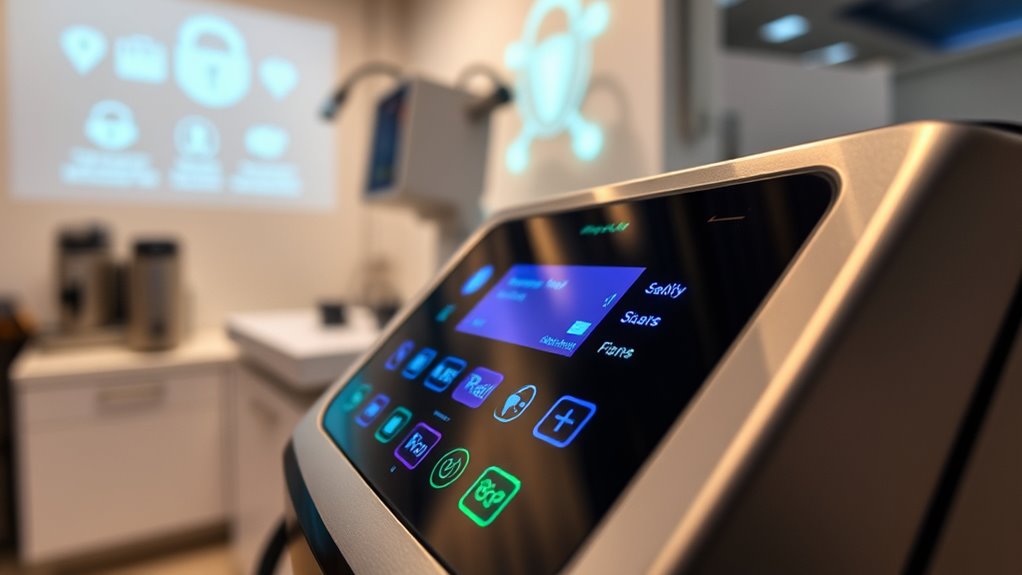
UL IoT Security Ratings are determined through a thorough evaluation process that tests a device’s security features against established standards. During this process, experts evaluate various aspects, such as network security, data protection, and software integrity. Additionally, security feature testing ensures that protections are robust and effective. Vulnerability scanning is conducted to identify potential risks, followed by penetration testing which simulates attacks to find weaknesses. The process also includes continuous monitoring to adapt to evolving cyber threats and maintain security integrity. This ongoing effort reflects the importance of creative practice in developing innovative and resilient security solutions. For example, incorporating aquatic exercise principles can inspire adaptable and flexible security measures. Incorporating personal development strategies can also enhance security teams’ resilience and problem-solving skills. Compliance verification ensures standards are met. This structured approach guarantees that your appliances are not only functional but also resilient against evolving cyber threats.
Key Components Evaluated in the Ratings
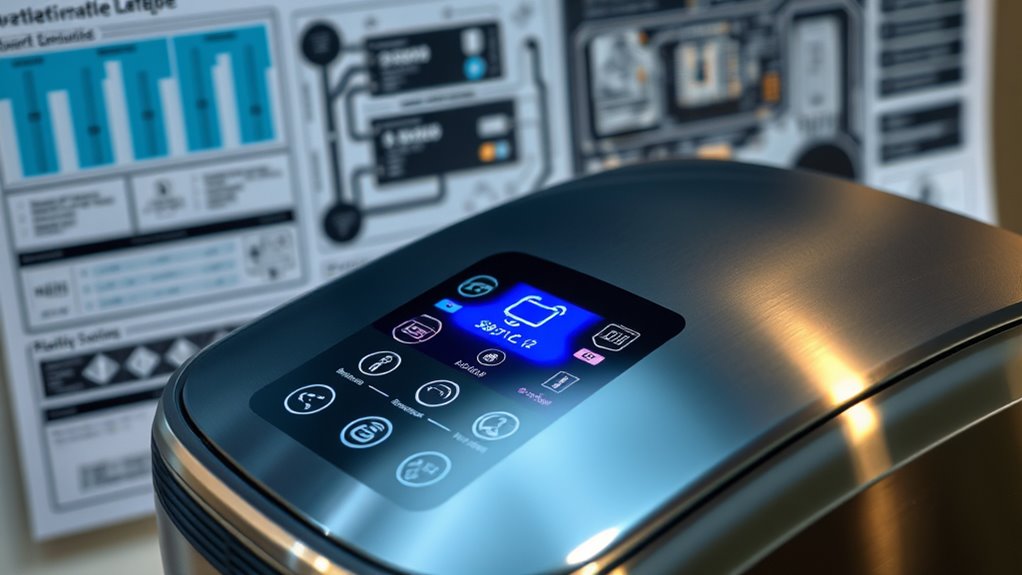
You’ll want to understand the key components that influence the ratings, starting with network security features. These determine how well your devices safeguard data during transmission. Additionally, firmware and update protocols ensure devices stay secure against emerging threats. Recognizing device security measures implemented in appliances can help you make more informed choices. Incorporating data-driven strategies can further optimize device performance and security resilience. Incorporating home automation integration can also enhance the security features of your appliances by enabling remote monitoring and control.
Network Security Features
Network security features are fundamental to ensuring the integrity and confidentiality of IoT devices within a connected environment. These features protect your appliances from unauthorized access and malicious attacks by implementing strong encryption protocols, secure communication channels, and authentication mechanisms. During the UL IoT security rating assessment, key components like secure network interfaces, encrypted data transmission, and device isolation are thoroughly evaluated. You want your appliances to support robust Wi-Fi or Bluetooth security standards, such as WPA3 or Bluetooth LE Security, to prevent eavesdropping and tampering. Additionally, features like network segmentation help contain potential breaches, limiting their impact. Incorporating regular security updates ensures that vulnerabilities are promptly addressed, further enhancing your device’s protection. Implementing robust encryption protocols can significantly reduce the risk of data breaches and unauthorized access, and adopting multi-factor authentication adds an extra layer of security against intrusions. Moreover, ensuring secure firmware updates can help prevent malicious code from infiltrating your devices. Overall, these network security components are essential for safeguarding your smart devices and maintaining a secure, reliable connected home.
Firmware & Update Protocols
Firmware and update protocols are critical components evaluated in the UL IoT security ratings because they directly influence a device’s ability to stay protected against emerging threats. When a manufacturer implements secure update procedures, you can trust that firmware can be refreshed safely without exposing the system to vulnerabilities. Secure protocols ensure updates are encrypted and authenticated, preventing hackers from injecting malicious code. If a device lacks reliable update mechanisms, it becomes vulnerable to malware and exploits that can compromise your privacy or damage the appliance. Regular, secure updates are essential for patching security flaws and improving functionality over time. As a user, you benefit from devices that can receive timely, safe firmware updates, maintaining security and performance throughout their lifespan.
Benefits of UL IoT Security Ratings for Consumers
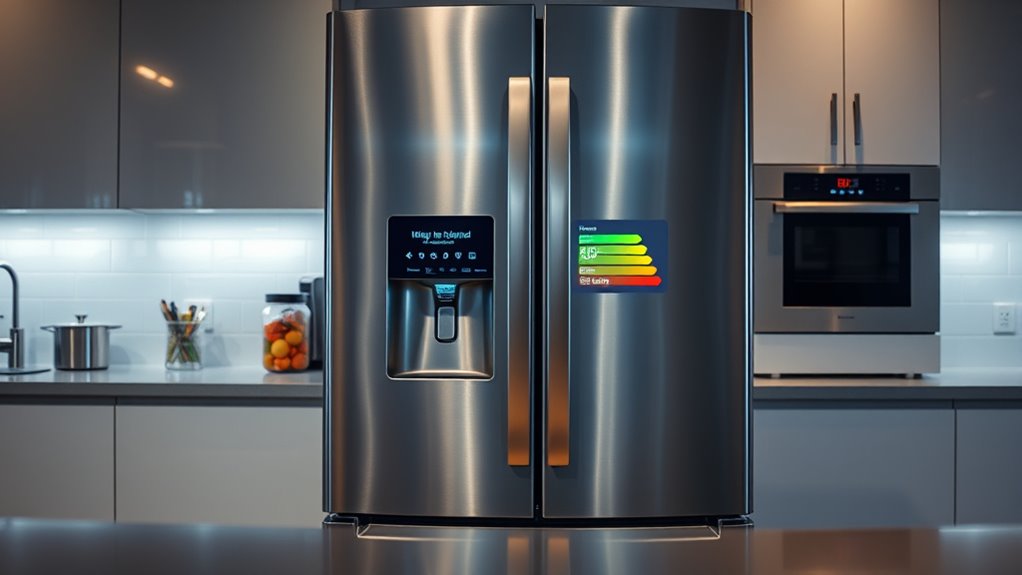
UL IoT Security Ratings offer consumers a clear and trustworthy way to identify devices that prioritize safety and privacy. With these ratings, you can easily compare appliances and make informed choices. Benefits include:
- Enhanced confidence in product security, reducing the risk of cyber threats.
- Simplified decision-making by providing transparent security information at a glance.
- Better protection of your personal data and home network from potential vulnerabilities.
Limitations and Considerations of the Ratings

While UL IoT security ratings provide useful insights, they have limitations you should consider. Transparency can be challenging, making it hard to understand exactly how scores are determined. Additionally, security standards vary across devices, which can affect the consistency of these ratings.
Rating Transparency Challenges
Despite the growing importance of IoT security ratings, transparency remains a significant challenge. You might find it hard to understand how ratings are determined or what standards are applied. This lack of clarity can lead to confusion and mistrust. To navigate this, consider these key issues:
- The criteria used for ratings often aren’t fully disclosed, making it difficult to assess their relevance.
- Different manufacturers may interpret or implement security measures differently, affecting consistency.
- Ratings might not reflect real-world performance, as testing conditions can vary widely.
These factors complicate your ability to compare appliances accurately. As a result, transparency gaps can undermine confidence in the ratings and limit their usefulness for making informed security decisions.
Varying Security Standards
The lack of transparency in security rating criteria becomes even more problematic when different standards and frameworks are used across manufacturers. You might find that one appliance’s security rating doesn’t align with another’s, even if they seem similar. Manufacturers often adopt varying security protocols, testing methods, and evaluation metrics, which complicates comparisons. This inconsistency can lead to confusion about a device’s actual security level, making it harder for you to make informed decisions. You may assume higher-rated appliances are more secure, but differing standards could mean they only meet less rigorous criteria. Without a universal benchmark, you need to scrutinize each rating carefully. Recognizing these variations helps you better assess the true security posture of IoT appliances you consider for your home.
Comparing Devices Using UL IoT Security Ratings
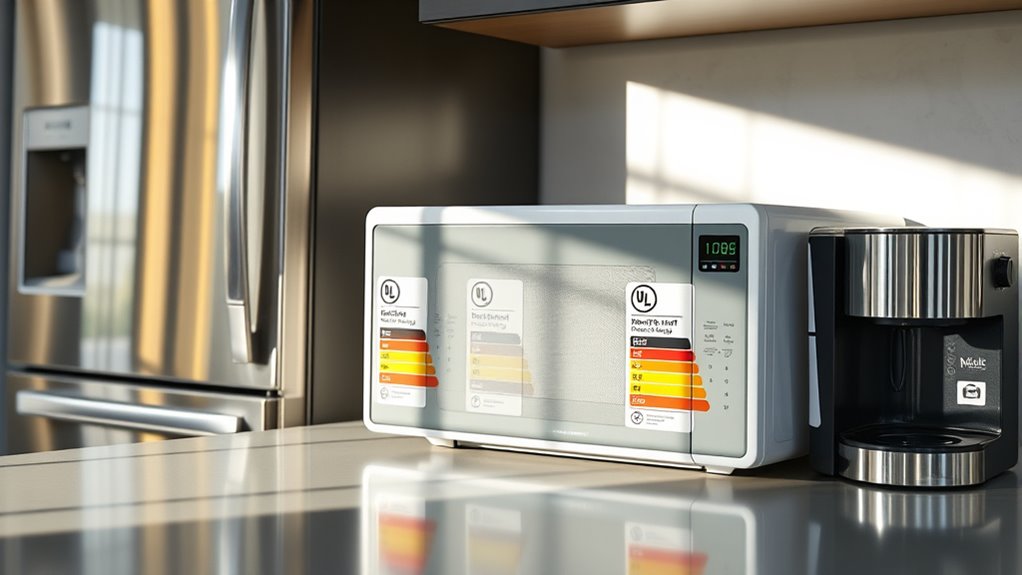
When comparing IoT devices, UL IoT Security Ratings provide a clear and standardized way to assess their security performance. These ratings help you identify strengths and weaknesses quickly. To compare effectively, focus on these key aspects:
- Security Level: Check the rating score to see how well the device protects against threats.
- Certification Scope: Review what security features and protocols are included in the rating.
- Update and Support: Consider how often the device receives security updates and the manufacturer’s commitment to ongoing protection.
Tips for Choosing Secure Connected Appliances
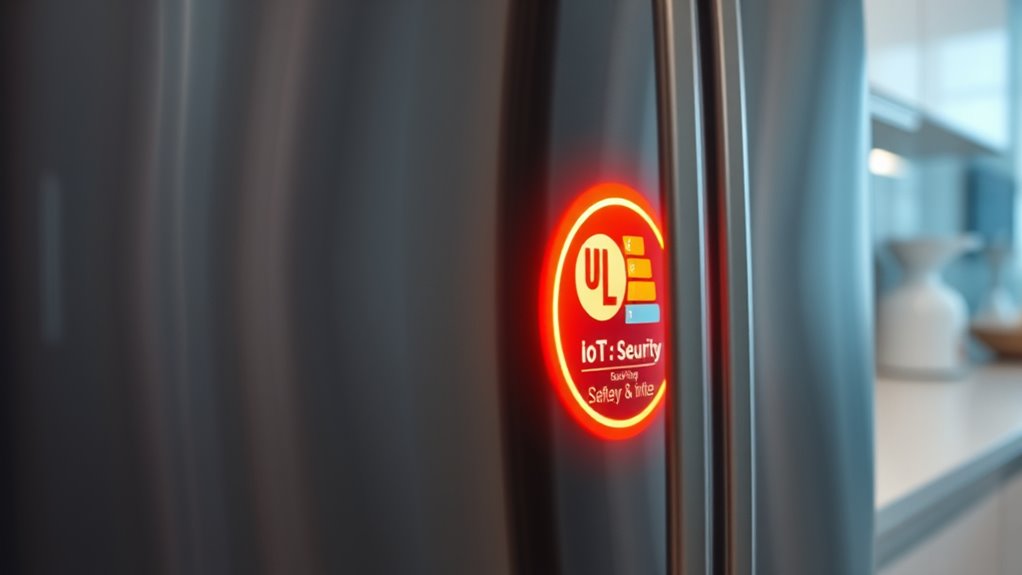
Choosing secure connected appliances requires careful attention to their security features and how well they protect your privacy. Look for devices with clear security ratings, such as UL IoT Security Ratings, which indicate their safety standards. Check if the appliance offers strong encryption, regular firmware updates, and multi-factor authentication. Avoid devices with default passwords or minimal security options. Research the manufacturer’s reputation for security practices and customer support. Read reviews to spot common vulnerabilities. Verify the appliance supports secure network connections, like WPA3 Wi-Fi encryption. Prioritize devices that are transparent about their security measures and comply with industry standards. Making informed choices helps safeguard your personal data and keeps your connected home secure from potential threats.
Frequently Asked Questions
How Often Are UL Iot Security Ratings Updated?
You’re wondering how often UL IoT security ratings get updated. Typically, these ratings are reviewed and refreshed annually to make certain they reflect the latest security standards and emerging threats. However, updates can happen more frequently if new vulnerabilities are identified or if there’s a significant change in security protocols. Staying informed about the latest ratings helps you choose safer appliances and keep your connected devices secure.
Do All Appliances Have UL Iot Security Ratings?
You might think all appliances have UL IoT security ratings, but that’s not the case. In reality, only certain smart or connected appliances undergo this evaluation, especially those with significant security concerns. Manufacturers submit their products for testing, so not every device is rated. If you’re concerned about security, check the product specifications or labels, as ratings help you identify safer, more secure appliances.
Can UL Ratings Predict Device Vulnerability to Hacking?
You might wonder if UL ratings can predict how vulnerable your device is to hacking. While UL security ratings evaluate a product’s security features, they don’t guarantee complete protection against hacking. These ratings help you compare devices’ security measures, but no system is entirely hack-proof. To stay safe, you should also follow best practices like using strong passwords and keeping firmware updated, alongside checking UL ratings.
Are UL Iot Security Ratings Recognized Internationally?
Think of UL IoT security ratings as international seals of trust. While some countries widely recognize these ratings, others may not. For example, a manufacturer I know gained global credibility after earning UL certification, much like a chef with a Michelin star. Recognized internationally, these ratings help consumers and businesses identify safer devices, but acceptance varies by region, so always check local standards before making a purchase or deployment decision.
How Do UL Ratings Compare to Other Security Certification Standards?
You want to compare UL ratings to other security standards. UL ratings focus specifically on IoT device safety and security, often aligning with international benchmarks, but they might differ from certifications like ISO or IEC standards. While UL emphasizes rigorous testing and certification, other standards may prioritize different aspects like data privacy or operational resilience. Ultimately, UL ratings offer a trusted, thorough assessment, but it’s wise to take into account multiple certifications for full security assurance.
Conclusion
Understanding UL IoT security ratings helps you make smarter choices when selecting connected appliances. These ratings, evaluated based on key security components, guide you toward safer devices. Did you know that nearly 60% of IoT devices have vulnerabilities that could be exploited? By paying attention to these ratings, you can reduce your risk and enjoy your smart appliances with greater confidence. Stay informed, prioritize security, and keep your connected home safe.









